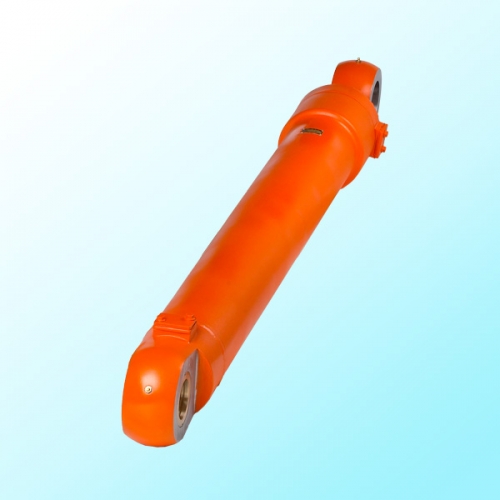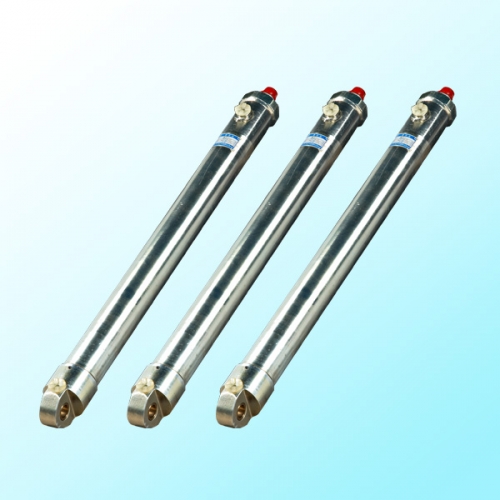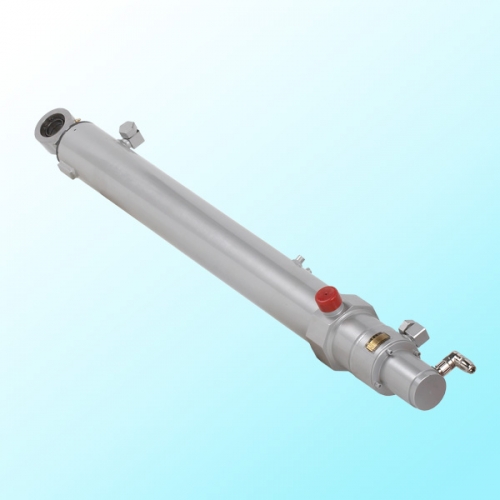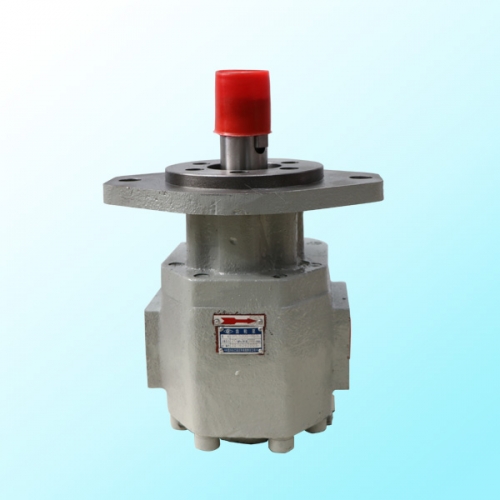Maintenance of hydraulic system of construction machinery and prevention of hydraulic cylinder cavitation failure
Release date:2018-10-08 作者: Click:
XNUMX. Maintenance of hydraulic system of construction machinery
1 Choose the right hydraulic oil
The hydraulic oil plays the role of transmitting pressure, lubricating, cooling and sealing in the hydraulic system. The improper selection of hydraulic oil is the main reason for the early failure of the hydraulic system and the decrease in durability.The hydraulic oil should be selected according to the brand specified in the random "Instruction Manual". When a substitute oil is needed in special circumstances, the performance should be the same as the original brand.Different brands of hydraulic oil cannot be mixed to prevent chemical reactions and performance changes of the hydraulic oil.Dark brown, milky white, and peculiar odor hydraulic oil is deteriorating oil and cannot be used.
2 Prevent solid impurities from mixing into the hydraulic system
Clean hydraulic oil is the life of the hydraulic system.There are many precision parts in the hydraulic system, some have damping holes, some have gaps, etc.If solid impurities invade, it will cause strains, hairpins, blockage of oil passages, etc., and endanger the safe operation of the hydraulic system.Common ways for solid impurities to invade the hydraulic system include: dirty hydraulic oil; dirty refueling tools; careless refueling, repair and maintenance; desquamation of hydraulic components, etc.The intrusion of solid impurities into the system can be prevented from the following aspects:
2.1 When refueling
The hydraulic oil must be filtered and refilled, and the refueling tools must be clean and reliable.The filter at the fuel tank filler opening cannot be removed in order to increase the fueling speed.Fueling personnel should use clean gloves and work clothes to prevent solid impurities and fiber impurities from falling into the oil.
2.2 During maintenance
Remove the hydraulic oil tank filler cap, filter cap, inspection hole, hydraulic tubing and other parts to avoid dust when the system oil passage is exposed. The disassembled parts must be thoroughly cleaned before opening.For example, when removing the hydraulic oil tank filler cap, first remove the dirt around the fuel tank cap, unscrew the fuel tank cap, remove the debris remaining in the joint (not flush with water to prevent water from seeping into the tank), and open the fuel tank cap only after confirming that it is clean.If you need to use a wiping material and a hammer, you should choose a wiping material that does not remove fiber impurities and a special hammer with rubber attached to the striking surface.The hydraulic components and hydraulic hoses should be carefully cleaned and assembled after drying with high-pressure air.Use genuine filter elements with intact packaging (the inner packaging is damaged, although the filter element is intact, it may be unclean).Clean the filter at the same time when changing the oil. Before installing the filter element, use wiping materials to carefully clean the bottom dirt in the filter housing.
2.3 Cleaning of hydraulic system
The cleaning oil must use the same brand of hydraulic oil as the system used. The oil temperature is between 45 and 80°C. Use a large flow to remove impurities from the system as much as possible.The hydraulic system should be cleaned more than three times repeatedly. After each cleaning of the second-hand excavator, let it out of the system while the oil is hot.After cleaning, clean the filter, replace the new filter element, and add new oil.
3 Prevent air and water from intruding into the hydraulic system
3.1 Prevent air intrusion into hydraulic system
At normal pressure and temperature, the hydraulic oil contains air with a volume ratio of 6-8%. When the pressure is reduced, the air will be released from the oil, and the burst of bubbles will cause the hydraulic components to "cavitation" and generate noise.A large amount of air entering the oil will aggravate the "cavitation" phenomenon, increase the compressibility of the hydraulic oil, work instability, reduce work efficiency, and cause "crawling" of the actuators.In addition, the air will also oxidize the hydraulic oil and accelerate the deterioration of the oil.The following points should be paid attention to to prevent air intrusion:
After maintenance and oil change, the air in the system must be removed in accordance with the provisions of the accompanying "Instruction Manual" before normal operation can be performed.The oil suction pipe port of the hydraulic oil pump must not expose the oil surface, and the oil suction pipe must be well sealed.The seal of the drive shaft of the oil pump should be good. It should be noted that when replacing the oil seal there should be a genuine "double lip" oil seal, instead of a "single lip" oil seal, because the "single lip" oil seal can only seal oil in one direction and does not have air sealing. Function.
3.2 Prevent water intrusion into hydraulic system
Excessive water content in the oil will rust hydraulic components, emulsify and deteriorate the oil, reduce the strength of the lubricant film, and accelerate mechanical wear.In addition to preventing moisture intrusion during maintenance, it should be noted that when the oil storage barrel is not in use, the lid should be tightened, and it is best to place it upside down; oil with high water content should be filtered many times, and the dried filter paper should be replaced every time it is filtered. When there is no special instrument for testing, the oil can be dropped on the hot iron plate, and there is no steam coming out and burning immediately before refilling.
4 Precautions during operation
4.1 Mechanical operations should be gentle and smooth
Rough mechanical operations should be avoided, otherwise impact load will inevitably occur, causing frequent mechanical failures and greatly shortening the service life.The impact load generated during operation will cause early wear, fracture, and breakage of mechanical structural parts on the one hand, and generate impact pressure in the hydraulic system on the other hand. The impact pressure will damage hydraulic components, oil seals, and pressure joints between high-pressure oil pipe joints and hoses. Premature failure of oil leakage or pipe burst, frequent action of overflow valve, oil temperature rise.There is another issue worth noting: the operator must remain stable.Because the free clearance of the control system of each equipment is different, the degree of wear of the connecting parts is different and the clearance is also different. The output of the engine and the hydraulic system is also different. These factors give the equipment its personality.Only the operator who uses the device carefully explores and corrects his manipulation actions to adapt to the personality of the device, and after long-term work, can he develop good operating habits that conform to the personality of the device.
4.2 Pay attention to cavitation and overflow noise
Always pay attention to the sound of the hydraulic pump and overflow valve during operation. If the hydraulic pump has "cavitation" noise, which cannot be eliminated after exhausting, it should be used after finding the cause and troubleshooting.If an actuator moves slowly when there is no load, accompanied by the sound of overflow valve overflow, it should be shut down immediately for maintenance.
4.3 Strictly implement the shift system
When the shift driver parks the machinery, it is necessary to ensure the safety of the shift driver during the inspection and check the accurate oil level.Whether the system leaks, whether the connection is loose, whether the piston rod and the hydraulic hose are damaged, whether the low-pressure oil inlet pipe of the hydraulic pump is connected reliably, and whether the oil level of the fuel tank is correct, etc., are the focus of the inspection of the hydraulic system by the succeeding driver.Atmospheric pressure tanks should also check and clean the tank vents to keep them unobstructed to prevent the vents from clogging and causing the tank to vacuum, which may cause damage to the hydraulic oil pump due to difficulty in sucking oil.
4.4 Maintain proper oil temperature
The working temperature of the hydraulic system is generally controlled between 30 and 80°C (dangerous temperature ≥100°C).Excessive oil temperature of the hydraulic system will cause: the viscosity of the oil is reduced, which is easy to cause leakage, and the efficiency is reduced; the strength of the lubricating oil film is reduced, which accelerates the wear of the machine; the formation of carbides and silt; the oxidation of the oil accelerates the deterioration of the oil quality; the oil seal, high pressure Premature aging of the hose, etc.
In order to avoid excessive temperature: do not overload the radiator for a long time; pay attention to the radiator heat sink not to be contaminated by oil, so as to prevent dust from adhering to affect the heat dissipation effect; maintain sufficient oil to facilitate the circulation and heat dissipation of the oil; do not work all day in the hot summer. Avoid the high temperature time at noon.When the oil temperature is too low, the oil has high viscosity, poor fluidity, high resistance, and low work efficiency; when the oil temperature is lower than 20°C, the hydraulic motors, valves, pipelines, etc. are easily damaged by sharp turns.At this time, it is necessary to warm up the engine, start the engine, and after idling for 3 to 5 minutes at no-load, increase the engine speed with the medium-speed throttle, and control the handle to make any action of the working device (such as the bucket of the excavator) to the limit position and keep it at 3 ~5min to heat up the hydraulic oil through overflow.If the oil temperature is lower, you need to appropriately increase the warm-up time.
4.5 Control of air pressure and oil volume of hydraulic oil tank
The pressure type fuel tank should always pay attention to the pressure of the fuel tank during work, and its pressure must be kept within the range specified in the accompanying "Instruction Manual".If the pressure is too low, the oil pump will easily be damaged due to insufficient oil suction. If the pressure is too high, the hydraulic system will leak oil and easily cause the low-pressure oil circuit to burst.For the equipment after maintenance and oil change, after exhausting the air in the system, check the oil level according to the "Instruction Manual" provided in the machine, stop the machine in a flat place, and recheck the oil level after the engine is turned off for 15 minutes, if necessary Be supplemented.
4.6 Other matters needing attention
Prevent falling rocks from hitting hydraulic cylinders, piston rods, hydraulic tubing and other components during operation.If there is a small click injury on the piston rod, use a whetstone to grind away the edges around the small point in time to prevent damage to the sealing device of the piston rod, and continue to use it without oil leakage.For equipment that has been stopped continuously for more than 24 hours, the second-hand loaders should be filled with oil into the hydraulic pump before starting to prevent the hydraulic pump from being damaged by dry grinding.
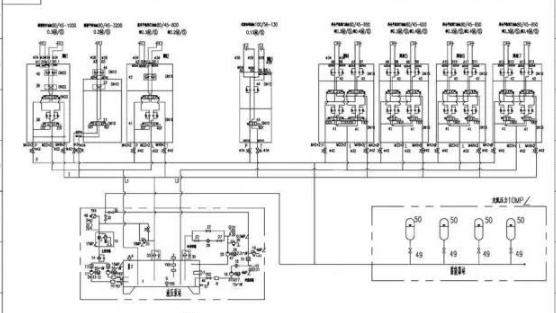
5 Precautions for regular maintenance
At present, some construction machinery hydraulic systems are equipped with smart devices. This device has warning functions for some hidden dangers in the hydraulic system, but its monitoring range and degree have certain limitations. Therefore, the inspection and maintenance of the hydraulic system should be based on the monitoring results of the smart device and the regular Combine inspection and maintenance.
5.1250h inspection and maintenance
Check the attachments on the filter screen, such as excessive metal powder, which often indicates the wear of the oil pump or the cylinder pulling. For this, the diagnosis and corresponding measures must be taken before the machine can be started.If the filter screen is damaged or dirt has accumulated, it should be replaced in time, and the oil should be changed at the same time if necessary.
5.2500h inspection and maintenance
No matter what the condition of the filter element is, it should be replaced, because it is difficult to detect the small damage of the filter element with the naked eye, and the filter element should be replaced in advance if it is operated at high temperature for a long time.
5.31000h inspection and maintenance
Clean the filter, replace the filter element, clean the hydraulic oil tank, and replace the hydraulic oil.The oil change time for long-term hot work should be advanced appropriately.Of course, it is the most economical to guide the oil change through oil quality inspection and analysis, but it is necessary to pay attention to the extended use of the oil. It should be tested every 100h in order to detect and replace the degraded oil in time.
5.47000h and 10000h inspection and maintenance
The hydraulic system needs to be inspected by professionals, and necessary adjustments and maintenance are carried out.According to practice, imported hydraulic pumps and hydraulic motors must be overhauled after 10000 hours of work, otherwise the hydraulic pumps and motors may be damaged due to disrepair, which will destroy the hydraulic system.
XNUMX. Construction machineryHydraulic cylinderPrevention of cavitation failure
1 The main cause of cavitation
1.1 The essential analysis of cavitation
Cavitation occurs mainly because a certain amount of air is mixed into the oil between the piston and the guide sleeve during the working process of the hydraulic cylinder.With the gradual increase in pressure, the gas in the oil will turn into bubbles. When the pressure rises to a certain limit, these bubbles will burst under the action of high pressure, thereby quickly acting on the high temperature and high pressure gas. On the surface of the part, it causes cavitation in the hydraulic cylinder, causing corrosive damage to the part.
1.2 Unqualified hydraulic oil quality leads to cavitation
Ensuring the quality of hydraulic oil is an important factor in preventing cavitation.If the oil has poor anti-foaming properties, it is easy to produce foam, which can lead to cavitation.Secondly, if the frequency of oil pressure changes is too fast or too high, it will directly cause the formation of bubbles and accelerate the bursting speed of the bubbles.Tests have proved that the rate of cavitation in the parts with high frequency of pressure changes will increase.Such as the hydraulic cylinder inlet and return ports, etc., due to the relatively high frequency of pressure changes, the degree of cavitation is relatively higher than other parts.In addition, overheating of the oil will increase the chance of cavitation.
1.3 Improper manufacturing and maintenance lead to cavitation
Because the hydraulic system is not fully exhausted during assembly or maintenance, there is gas in the system, which can cause cavitation under the action of high temperature and high pressure.
1.4 The quality of the coolant causes cavitation
When the coolant contains corrosive media, such as various acid radical ions, oxidants, etc., it is prone to chemical and electrochemical corrosion. Under their combined action, the speed of cavitation will also be accelerated; if the cooling system is well maintained, it can be To prevent the occurrence of cavitation, cranes.For example, if the pressure cover of the radiator of the cooling system is well maintained, the pressure of the radiator's coolant can always be higher than the vapor pressure, thereby preventing cavitation.Another example is the thermostat of the cooling system; a thermostat with good performance can keep the coolant in a suitable temperature range, and can reduce the energy released when the bubble bursts.
2 Measures to prevent cavitation
Although there are many causes of cavitation, as long as necessary measures are taken to actively prevent it, cavitation can still be avoided.In the following, we will talk about the preventive measures that should be taken to address the causes of cavitation.
2.1 Strictly select hydraulic oil
Select hydraulic oil in strict accordance with the oil standard.The selection of good quality hydraulic oil can effectively prevent air bubbles from appearing in the hydraulic system during the working process.When selecting oil, it should be selected according to the lowest temperature in different regions, and the hydraulic oil should be filled according to the standard of the dipstick. At the same time, the hydraulic system should be kept clean (when filling the hydraulic oil, prevent moisture and other impurities from being brought into ), often check the oil quality, oil level and oil color of the hydraulic oil. If you find blisters, bubbles, or the oil turns milky white in the hydraulic oil, you should carefully find the source of the air in the oil and eliminate it in time.
2.2 Prevent excessive oil temperature and reduce hydraulic shock
Reasonable design of the heat dissipation system to prevent the oil temperature from being too high is the key to keeping the hydraulic oil temperature normal.If an abnormality occurs, the cause should be found and eliminated in time.When operating the hydraulic joystick and distribution valve, it is necessary to strive for stability, not to be too fast or too violent, nor to increase the engine throttle frequently, so as to minimize the impact of hydraulic oil on the hydraulic components.At the same time, the cooling system should be maintained in time to keep the temperature of the cooling system within an appropriate range to reduce the energy released when the bubble bursts.While not affecting the normal circulation of the coolant, a certain amount of anti-corrosion additives can be appropriately added to inhibit rust.
2.3 Maintain the normal clearance of the joint surface of each hydraulic component
When manufacturing or repairing the main parts of the hydraulic cylinder (such as cylinder block, piston rod, etc.), the assembly should be carried out according to the lower limit of the assembly size tolerance. Practice has proved that this can well reduce the occurrence of cavitation.If the hydraulic components have already experienced cavitation, the metallographic sandpaper polishing technology can only be used to remove the pitting and surface carbon of the cavitation. Do not use ordinary fine sandpaper for polishing.
2.4 Pay attention to exhaust when repairing
After the hydraulic cylinder is repaired, the hydraulic system should be operated smoothly for a certain period of time so that the hydraulic oil in the hydraulic system can be fully circulated; if necessary, the oil inlet pipe (or return pipe) of the hydraulic cylinder can be disassembled to make the hydraulic oil overflow , In order to achieve the effect of single hydraulic cylinder exhaust.
The URL of this article: http://www.sccjyy.cn/news/388.html
Key words:Hydraulic system,Hydraulic cylinder,Hydraulic system manufacturers
Recently Viewed:
- A "Blue Book" was delivered to the door, tax companies gathered together to talk about party building and epidemic prevention work
- Reasons for the motor heating during the use of the gear pump
- What should I do if the piston rod in the hydraulic cylinder leaks out?
- The company organizes personnel to participate in fire safety training
- Changjiang Hydraulics participated in the video training of safety production list management work
- The requirements for hydraulic oil in the hydraulic system must be understood
- Hydraulic gear pump fault repair, bring you up knowledge
- How should the multi-way valve of a compressed garbage truck be repaired?
- Technical analysis of gear pump and plunger pump in mechanical engineering
- Changjiang Hydraulic participated in the XNUMXth West Expo
Related Products:
related news:
- The company's trade union won the first prize of the Municipal Federation of Trade Unions' work goal assessment
- Press the "accelerator key" for epidemic prevention and production
- Knowledge of hydraulic cylinder models and size standards
- The Party Committee of Changye Company deepens the theme activity of "1553 Party Building Project"
- Hydraulic cylinder performance test method and test result analysis
- In which industries are hydraulic cylinders commonly used
- Matters needing attention when disassembling engineering hydraulic cylinder
- The functions and common faults of various components of hydraulic cylinder excavators
- Summary of maintenance and repair points of hydraulic cylinders
- Changjiang Hydraulics won the title of "Demonstration Enterprise for Establishing Modern Enterprise System"


